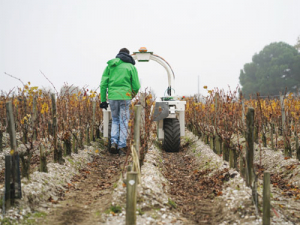Halter goes global, but NZ farmers remain core to innovation
Virtual fencing company Halter is going global but for founder Craig Piggott, New Zealand farmers will always remain their main partners.
 Meet Ted the vineyard robot trialed in Bordeaux and Portugal recently. It has been used for weeding and under vine cultivation.
Meet Ted the vineyard robot trialed in Bordeaux and Portugal recently. It has been used for weeding and under vine cultivation.
One thing is certain according to Dr Dave Jordan [Vine to Wine] — the vineyards of the future will not replicate the vineyards of today.
With the unassailable and rapidly increasing march of change, growers need to be looking ahead to the future, and making decisions now to be able to adapt.
It is not an easy task given the wine industry overall is steeped in tradition. In terms of the vineyard, change takes time.
“We have a five-year lead time to full production and we have an expected life of 20 years plus,” he said at the Bragato conference. “But is that going to be the norm going forward? I suggest not.”
So how do growers prepare for the future? Firstly Jordan suggested being agile in terms of the varietals and clones you choose now. For example should you be considering varietals that have multiple uses, such as Chardonnay which can be utilised in a sparkling or a table wine?
Then you need to be looking at getting ahead of the trends. It is too late to be contemplating a varietal change from say Sauvignon Blanc to Gruner Veltliner, once the market has already embraced the new style.
“I encourage my clients to be thinking about five percent of their planting as part of the new and upgrade part of their vineyard. But if you start taking five percent of your vineyard out of production, you need to have the capacity to reward yourself economically and financially while you continue to upgrade.”
Failing to do a little bit each year, and waiting either until a new trend is established, or your vineyard life span has reached its end, will be catastrophic.
“If you don’t take that approach, you will end up finding your vineyard asset will be devalued by the minute as it starts to become less and less aligned with the future.” As well as being aligned with future wine market trends,
Jordan also advised growers to look for the “pain points” in their business and the need to provide modern solutions to move forward. Examples of pain points are the cost of labour that is squeezing the profit margin for all. While easy to identify, he says it isn’t so easy to solve, especially given roughly 70 percent of all operating costs for grape growers, relate to labour.
Mechanisation and removing the human footprint from the vineyard is one way of easing that pain point. He used the example of Klima (mechanical pruning) as one of the innovations that is helping reduce labour costs. But more will come. Mechanical picking, driverless tractors, robots in the vineyard are all likely to be introduced in the next few years. So what does that mean for the traditional vineyard? Will it look the same as it does now? Will the traditional parallel rows be the best way to lay out a vineyard, will they serve the new technology appropriately?
“Will you need the same row width, headlands, vine height, row lengths? What other changes would happen if we weren’t configured around the existing tractor?”
The other pain point, which is coming much sooner than expected, is “life beyond Roundup”.
“No matter how much objective information we could put out there about the merits or otherwise of glyphosate, we are not going to get away from the emotive vote of our consumers thinking it is bad. We need to be thinking about that now.”
It’s not just glyphosate, it is all pesticides. How will growers deal with increasing disease pressure and less pesticides available to treat them? Maybe the time is coming where as a community we need to be looking at gene editing as we are seeing rapid and viable use of this technology in stem cell research. Jordan said he believes as the medical profession adopts this new technology to benefit health, it will open the public’s mind to the pros, rather than the cons of such technology when it comes to food crops.
All of these issues affect vineyards themselves, but Jordan also pointed out that the changing market, where consumers are crying out for new and fresh will also change the world of wine in the future. Placing your head in a bucket of sand and hoping it won’t affect you is tantamount to rolling over and dying. Instead, the industry needs to Look ahead and think smart.